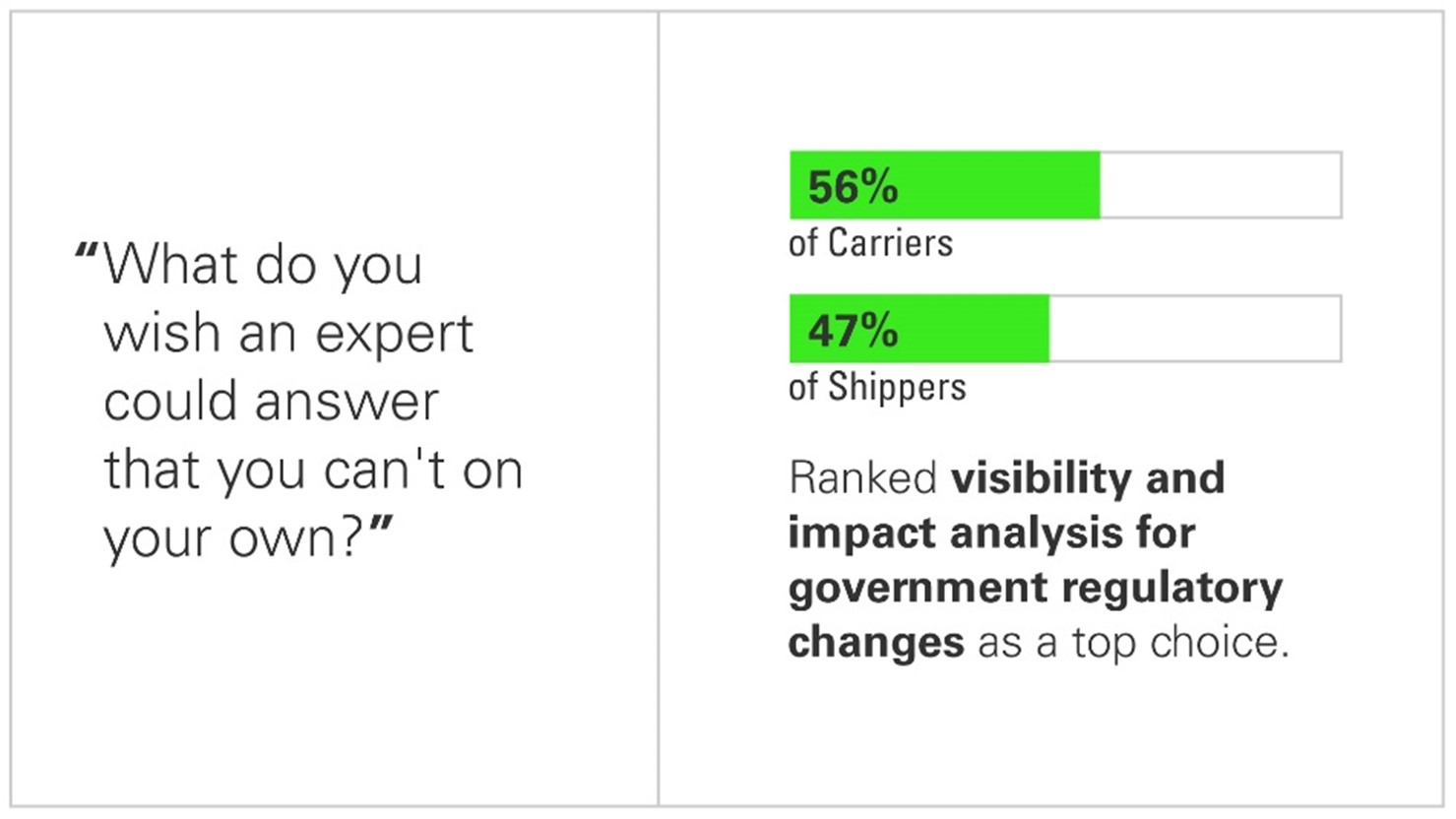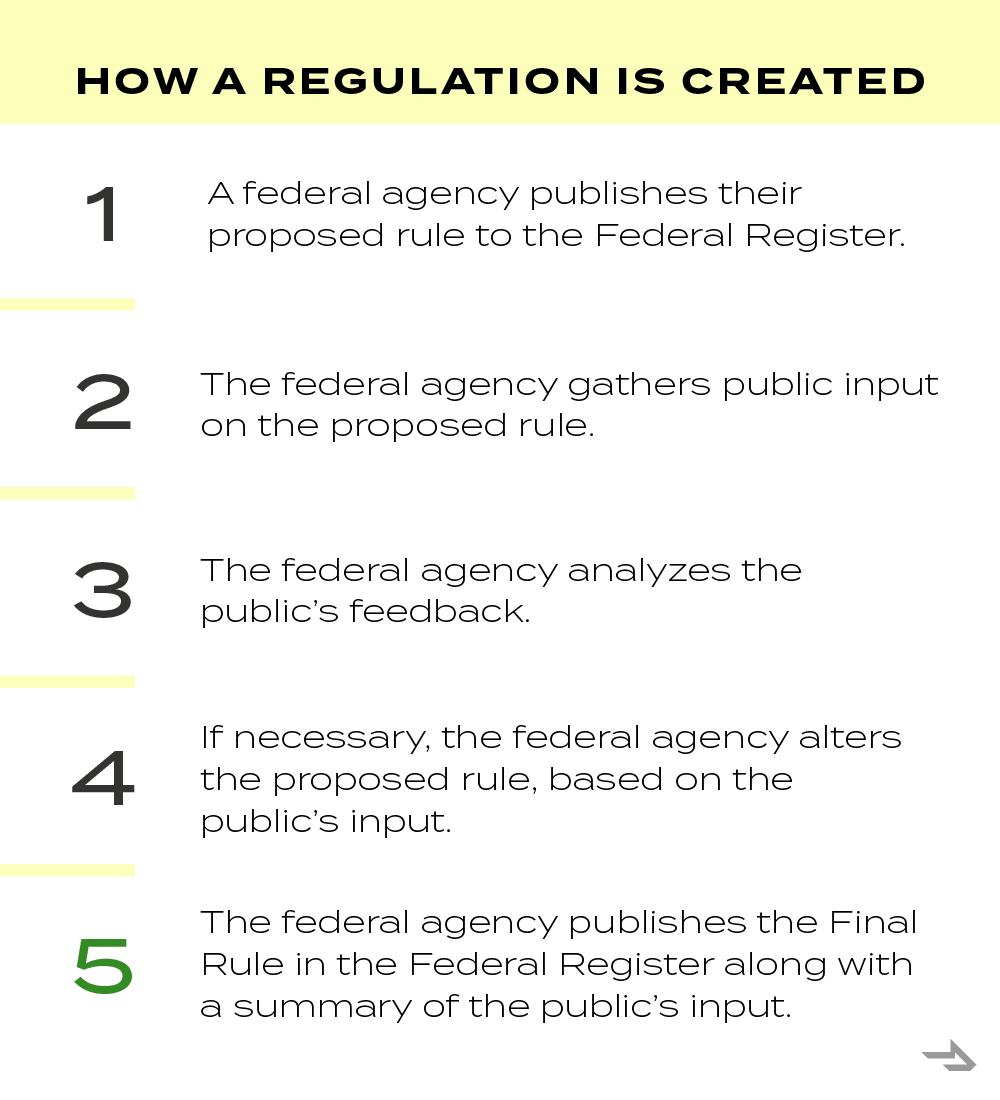How Transportation Policy Impacts the Supply Chain: 4 Important Facts for Shippers & Carriers
If you have ever felt unsure about how transportation policy impacts your business, don’t worry — you’re in good company.
In an original research study we conducted, 56% of carriers and 47% of shippers surveyed wished they had more visibility into supply chain regulations and expert guidance on the impact of policy changes.
This was especially true for carriers, who chose “keeping up with government regulations” as their second biggest business challenge.
The body of federal supply chain laws and regulations is massive and complex. Factor in state and local laws, and it can get very difficult to monitor and interpret transportation-related policies.
While keeping up with policy changes and navigating new processes can be confusing, a basic understanding of government’s role in the transportation industry doesn’t have to be.
Here are four basic principles to help give you a solid foundation so you better understand the laws and regulations of the transportation industry.
1. Developing & Enforcing Policy Is a Collaborative Effort
Federal and state governments both play key roles in shaping the transportation landscape.
Regulating such a large and complex industry is no small task, requiring collaboration between numerous agencies, departments and branches at the federal, state and local-levels of government.
Before we dive into the specifics of their collective impact on the supply chain, let’s brush up on the basic structure of government in the U.S.
The U.S. federal government comprises three branches: the legislative branch, executive branch, and judicial branch.
The 3 Branches of the Government
- Legislative Branch: makes laws, consists of two chambers — the Senate and the House of Representatives. Together, these chambers are known as Congress.
- Executive Branch: enforces laws, consists of the President, Vice President, the Cabinet (an advisory body made up of 15 department heads) and independent federal agencies.
- Judicial Branch: evaluates laws, consists of the Supreme Court and other federal courts.
State governments also have legislative, executive and judicial branches.
At the state level, an elected Governor is the head of the executive branch, while the legislative and judicial branches structurally similar to the federal government.
Federal laws and regulations are important, but state legislatures and departments also affect the industry. Read about how California’s AB5 law has impacted trucking companies.
2. The DOT Consists of Several Smaller Agencies
Both federal and state governments influence the transportation industry through legislation, infrastructure spending, safety regulations and funding.
Within the U.S. government, there are numerous federal agencies that carry out these functions, but the largest and most recognizable is the Department of Transportation (DOT).
The DOT falls under the executive branch, and is the primary regulatory agency for transportation in the United States.
Official Mission of the DOT:
To ensure America has the safest, most efficient and modern transportation system in the world, which boosts our economic productivity and global competitiveness and enhances the quality of life in communities both rural and urban.
Within the DOT are several smaller federal agencies, also known as administrations. Here’s a snapshot of two prominent DOT administrations:
Federal Motor Carrier Safety Administration (FMCSA)
The FMSCA was established by the DOT on January 1, 2000 to improve the safety of commercial motor carrier operations.
Most every trucking company is familiar with the FMCSA in it’s capacity regulating driver hours of service (HOS).
In recent years, the FMSCA approved changes to hours of service (HOS) regulations and published the HOS Final Rule, which took effect on September 29, 2020.
Here’s an overview of all of FMSCA’s responsibilities:
- Develops standards to test/license commercial motor vehicle drivers.
- Provides states with financial assistance for roadside inspections and commercial motor vehicle safety programs.
- Creates safety regulations for commercial motor carriers.
- Collaborates with motor carriers, labor safety interest groups, and federal, state and local enforcement agencies.
- Their primary mission is to “reduce crashes, injuries and fatalities involving large trucks and buses.”
National Highway Traffic Safety Administration (NHTSA)
The NHTSA was established by the Highway Safety Act of 1970 to reduce deaths, injuries and economic losses due to motor vehicle crashes.
To accomplish this, the NHTSA:
- Investigates safety defects in motor vehicles and enforces vehicle performance standards.
- Provides grants to state governments so they can facilitate highway safety programs.
- Sets and enforces fuel economy standards.
- Conducts research on driver behavior and traffic safety to target the most effective safety improvements.
The FMCSA and the NHTSA are just two agencies that fall under the DOT. In total, there are 11 distinct DOT agencies, each with different responsibilities to make sure our nation’s supply chains keep moving.
3. Transportation Laws & Regulations Are Similar, but Different
Even if you don’t fully understand or agree with supply chain laws and regulations, you are required to comply with both — and violations can result in penalties.
From the average supply chain professional’s perspective, laws and regulations are effectively the same thing. However, they are actually separate policies created by two different branches of government using two different processes.
Laws
Federal laws, also known as statutes, are created by an act of Congress (legislative branch).
A law begins as a proposal (a bill) which must be introduced by a sponsoring member from either the Senate or House of Representatives.
To become a law, a bill must undergo an extensive approval process and ultimately pass both chambers of Congress and earn the president’s approval.
Since this process involves so much back-and-forth and depends on the agreement of so many decision-makers, most bills do not become laws.
For reference, of the 17,817 bills proposed by the 117th Congress (between Jan. 3, 2021-Jan. 3, 2023), only 2% were enacted as laws.
Example of a Transportation Law:
The Infrastructure Investment and Jobs Act, was passed by Congress and signed into law by President Joe Biden on November 15, 2021.
This Act, commonly known as the infrastructure bill, authorized a record investment in infrastructure maintenance and improvements, $1.2 trillion over a 10-year period. Among other things, this funding will be used to repair roads and bridges; modernize rail lines, airports and seaports; and develop a national network of electric vehicle chargers.
Additional examples of laws: Fixing America’s Surface Transportation Act, Motor Vehicle Safety, Highway Safety
Regulations
Regulations, also known as rules, are created by federal agencies (executive branch).
Regulations are enacted to explain how various agencies will carry out state statutes and federal laws.
The process of creating a regulation is known as rulemaking. This process is far less involved than lawmaking.
Here are the five steps of the rulemaking, or regulatory, process:
First, a government agency publishes their proposal in the Federal Register, a publicly available database that contains agency rules, proposed rules and public notices (this register is updated by the U.S. government on a daily basis).
After issuing a proposed rule, federal agencies gather public comments through online submissions and, occasionally, public hearings.
During this stage of the process, any interested party (individuals as well as groups) can submit their feedback about the proposed rule.
After considering public comments and altering the proposed rule (if necessary), the federal agency publishes the Final Rule in the Federal Register along with a synopsis of public comments, the agency’s response to those comments and the date the rule goes into effect.
Example of a Transportation Regulation:
On June 1, 2020, the Federal Motor Carrier Safety Administration (FMCSA) — a DOT agency — published an updated Hours of Service Final Rule, which went into effect on September 29 of that year.
Four revisions were included in this update:
- Loosening the requirement for when drivers can take their mandated 30-minute break.
- Giving drivers more flexibility for when to take off-duty hours.
- Extending the grace period for drivers to complete runs in adverse driving conditions.
- Expanding the radius for the short-haul exception to hours of service tracking.
Additional examples of transportation regulations include the Federal Motor Vehicle Safety Standards – Air Brake Systems and the Clearinghouse Final Rule.
4. You can influence government policies.
As the rulemaking process suggests, public opinion is an important part of policymaking.
Decision-makers pay attention to input from logistics professionals across the country when it comes to shaping and passing new legislation.
Across the transportation industry, trade associations, supply chain councils and privately owned businesses are working together to appeal to government agencies on behalf of shippers, carriers and other supply chain professionals.
Some well-known transportation trade associations include:
- Consumer Brands Association (CBA)
- American Trucking Associations (ATA)
- National Private Truck Council (NPTC)
- Owner-Operator Independent Drivers Association (OOIDA)
Ultimately, shipper and carrier input is incredibly important. By sharing their experiences, supply chain professionals help shape the laws and regulations that govern the industry.
Dive Deep into a Government Transportation Regulation
Want to learn more about one of the major recent transportation policies shaping the industry?
Read our deep dive on the FMCSA Hours of Service Rule and learn how its impacting motor carriers and shipper supply chains nationwide.






